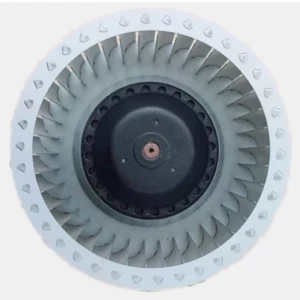Manufacturers address issues related to cavitation and air leakage in forward curved centrifugal fans through various design and engineering strategies, as well as quality control measures.
Here’s how they typically handle these issues:
- Optimized Impeller Design: Manufacturers carefully design the impeller geometry to minimize the risk of cavitation. This may involve selecting an appropriate blade profile, curvature, and spacing to ensure smooth airflow and minimize pressure differentials that could lead to cavitation.
- Material Selection: High-quality materials with excellent corrosion resistance and structural integrity are chosen for constructing the fan components, including the impeller, housing, and inlet cone. This helps prevent wear and erosion, reducing the likelihood of cavitation and air leakage over time.
- Surface Finish: Manufacturers pay attention to the surface finish of critical components to reduce roughness and turbulence, which can exacerbate cavitation tendencies. Smooth surfaces help maintain laminar airflow and minimize the formation of air bubbles or vapor pockets that lead to cavitation.
- Precise Manufacturing Tolerances: Tight manufacturing tolerances are maintained to ensure precise alignment and fitment of components, minimizing gaps or inconsistencies that could result in air leakage. This includes precise machining of mating surfaces and careful assembly procedures to create airtight seals.
- Seal Design: Effective sealing mechanisms are incorporated into the fan design to prevent air leakage at key locations such as the shaft, ec centrifugal fan bearings, and housing joints. This may involve the use of labyrinth seals, lip seals, or mechanical seals engineered to withstand the operating conditions and prevent leakage paths.
- Balancing: Dynamic balancing of the impeller and rotor assembly is performed to minimize vibration and ensure smooth operation. Imbalanced components can lead to uneven airflow distribution and localized pressure differentials, increasing the risk of cavitation and air leakage.
- Performance Testing: Comprehensive performance testing is conducted on the fan units to verify their aerodynamic performance and identify any areas of concern, such as cavitation tendencies or air leakage points. Testing may include flow visualization techniques, pressure mapping, and computational fluid dynamics (CFD) simulations to assess airflow characteristics and identify potential improvements.
- Quality Control: Stringent quality control measures are implemented throughout the manufacturing process to detect and rectify any deviations from design specifications. This includes inspections, testing, and validation procedures to ensure that the finished fan units meet performance, safety, and reliability requirements.
By implementing these design, engineering, and quality control measures, manufacturers can effectively address issues related to cavitation and air leakage in forward curved centrifugal fans, ensuring optimal performance, efficiency, and reliability in various industrial and HVAC applications.
How does the quality of the motor influence the overall performance of the ec centrifugal fan?
The quality of the motor in an EC (Electronically Commutated) centrifugal fan significantly influences its overall performance in several key ways:
- Efficiency: A high-quality motor is typically more efficient, converting a higher percentage of electrical energy into mechanical energy. In an EC centrifugal fan, which relies on an efficient motor for operation, this translates to improved overall system efficiency and lower energy consumption.
- Power Density: Motors of higher quality tend to have higher power densities, meaning they can produce more power within a smaller footprint. This allows for the design of more compact EC centrifugal fans without sacrificing performance, making them suitable for applications where space is limited.
- Precision Control: Quality motors offer precise control over speed and torque, which is essential for optimizing the performance of an EC centrifugal fan. This precise control allows for variable speed operation, enabling the fan to adjust its output to match changing system requirements and achieve optimal energy efficiency.
- Smooth Operation: High-quality motors operate more smoothly and quietly, minimizing vibrations and noise during fan operation. This results in a more comfortable and pleasant environment for occupants, making EC centrifugal fans suitable for noise-sensitive applications such as HVAC systems in residential or commercial buildings.
- Reliability and Durability: Motors of superior quality are typically more reliable and durable, with longer service lives and reduced maintenance requirements. This translates to improved uptime and reduced lifecycle costs for EC centrifugal fan systems, making them a cost-effective long-term solution for various applications.
- Environmental Considerations: High-quality motors often incorporate advanced technologies and materials that contribute to environmental sustainability. For example, they may feature higher efficiency ratings, lower emissions,ec backward curved centrifugal fan and reduced use of hazardous materials, aligning with energy efficiency and environmental regulations.
- Integration with Control Systems: Quality motors are designed for seamless integration with control systems, allowing for advanced functionality and customization options. In an EC centrifugal fan, this integration facilitates smart control strategies such as variable speed regulation, on-demand operation, and network connectivity for remote monitoring and control.
- Compliance with Standards: Motors manufactured to high-quality standards comply with industry regulations and safety standards, ensuring their suitability for use in EC centrifugal fans across various applications. Compliance with standards also provides assurance of product quality, performance, and safety to end-users and regulatory authorities.
Overall, the quality of the motor in an EC centrifugal fan is critical for achieving optimal performance, efficiency, reliability, and environmental sustainability. Investing in a high-quality motor ensures that the fan system operates at peak efficiency, delivers consistent performance, and meets the demands of diverse applications with minimal maintenance requirements and downtime.
